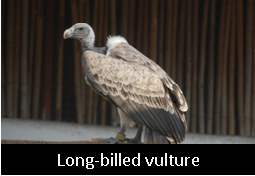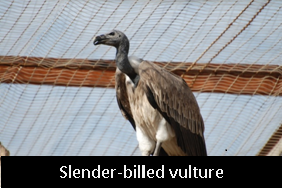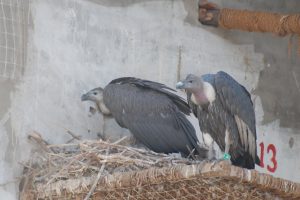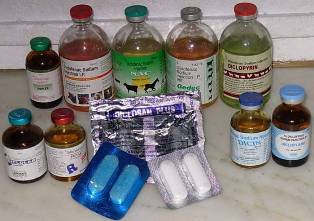The Vulture Conservation Breeding Centre (VCBC) is a joint project of the Haryana Forest Department and the Bombay Natural History Society (BNHS). It is a collaborative initiative to save the three species of vultures, the White-backed, Long-billed and Slender-billed, from looming extinction.
The VCBC, earlier known as Vulture Care Centre (VCC), was established in September 2001 with the UK Government’s ‘Darwin Initiative for the Survival of Species’ fund, to investigate the dramatic declines in India’s Gyps species of vultures.
Subsequent to the release of the South Asia Vulture Recovery Plan in February 2004, the VCC was adapted and upgraded to being the first VCBC, in line with a key recommendation of the Recovery Plan to set up a conservation breeding programme for the three critically endangered species of vultures. The centre sprawls over 5 acres of Haryana Forest Department’s land at village Jodhpur. The Jatayu Conservation Breeding Centre (JCBC) is a joint project of the Haryana Forest Department and the Bombay Natural History Society (BNHS).It is a collaborative initiative to save the three species of vultures, the White-backed, Long-billed and Slender-billed, from looming extinction. The centre is located at village Jodhpur on the edge of the Bir Shikargaha Wildlife Sanctuary which is about 8 km off the National Highway-22 from Pinjore on Mallah Road. The centre is spread on a 5 acre land of Haryana Forest Department.
 The JCBC, earlier known as Vulture Care Centre (VCC), was established in September 2001 with the UK Government Darwin Initiative for the Survival of Species’ fund, to investigate the dramatic declines in the resident Gyps species of vultures.
The JCBC, earlier known as Vulture Care Centre (VCC), was established in September 2001 with the UK Government Darwin Initiative for the Survival of Species’ fund, to investigate the dramatic declines in the resident Gyps species of vultures.
Subsequent to the release of the South Asia Vulture Recovery Plan in February 2004, the VCC was adapted and upgraded to being the first JCBC, in line with a key recommendation of the Recovery Plan to set up a conservation breeding programme for the three critically endangered Gyps species of vultures.
 At present the centre houses a total 160 Vultures which includes 63 White-backed Vultures, 74 Long-billed Vultures, 21 Slender-billed Vultures and 2 Himalayan Griffons. This is the largest collection of the three critically endangered Gyps species of vulture at one place anywhere in the world.
At present the centre houses a total 160 Vultures which includes 63 White-backed Vultures, 74 Long-billed Vultures, 21 Slender-billed Vultures and 2 Himalayan Griffons. This is the largest collection of the three critically endangered Gyps species of vulture at one place anywhere in the world.
A planned conservation breeding programme was initiated with the financial assistance from the Central Zoo Authority, Darwin Initiative for the Survival of Species of the Government of U.K., the Royal Society for the Protection of Birds (RSPB) and technical support of the Zoological Society of London and International Centre for Birds of Prey, U.K. The Centre is the first centre of its kind in Asia and is poised to make major contributions in the conservation of these critically endangered species. It was designated as the Coordinating Zoo for Vulture Conservation in India by the Central Zoo Authority.
Diclofenac implicated as the main cause of vulture decline
 The centre played an important role in confirming that diclofenac, a non-steroidal anti-inflammatory drug, given to cattle to treat pain and inflammation, was the main cause of vulture mortality and population crash in vultures. The diclofenac was extracted from the tissue samples of vulture carcasses which were collected from different parts of the country and its presence was estimated in collaboration with Aberdeen University, UK. It was found that 75% of the vulture carcasses collected from various parts of the country had “Visceral Gout”. This happens when there is kidney failure and the uric acid crystals get deposited on the visceral organs. It was established that all the vultures which had died of visceral gout had diclofenac residues in their tissues. This strong correlation established that at least 75% of the vulture population had died of diclofenac poisoning and this was the major cause of decline. The diclofenac as the major cause of vulture mortality was first established in 2003-04 by The Peregrine Fund, a U. S. based NGO, working in Pakistan. Vultures are exposed to diclofenac when they feed from carcasses of livestock that have died within a few days of treatment and contain residues of the drug. The concentration of diclofenac, as low as 0.22 mg/gm of body weight, was found to be lethal to vultures.
The centre played an important role in confirming that diclofenac, a non-steroidal anti-inflammatory drug, given to cattle to treat pain and inflammation, was the main cause of vulture mortality and population crash in vultures. The diclofenac was extracted from the tissue samples of vulture carcasses which were collected from different parts of the country and its presence was estimated in collaboration with Aberdeen University, UK. It was found that 75% of the vulture carcasses collected from various parts of the country had “Visceral Gout”. This happens when there is kidney failure and the uric acid crystals get deposited on the visceral organs. It was established that all the vultures which had died of visceral gout had diclofenac residues in their tissues. This strong correlation established that at least 75% of the vulture population had died of diclofenac poisoning and this was the major cause of decline. The diclofenac as the major cause of vulture mortality was first established in 2003-04 by The Peregrine Fund, a U. S. based NGO, working in Pakistan. Vultures are exposed to diclofenac when they feed from carcasses of livestock that have died within a few days of treatment and contain residues of the drug. The concentration of diclofenac, as low as 0.22 mg/gm of body weight, was found to be lethal to vultures.
Ban on the veterinary use of Diclofenac in India
 The centre played a crucial role in getting the veterinary use of diclofenac banned in the country. This became possible because of the efforts taken by the then Hon’ble Forest Minister, Ms. Kiran Choudhry. She met the Prime Minister and the Chairperson of the ruling United Progressive Alliance and effectively convinced them to ban the veterinary use of diclofenac as it was responsible for the crash in vulture populations. The Drug Controller General of India instructed vide his letter dated 11 May 2006, to all the state drug controllers to withdraw the licences granted to manufacture diclofenac formulations for veterinary use. The final gazette notification was issued in August 2008. The BNHS advocacy programme worked tirelessly behind the scene to make this happen.
The centre played a crucial role in getting the veterinary use of diclofenac banned in the country. This became possible because of the efforts taken by the then Hon’ble Forest Minister, Ms. Kiran Choudhry. She met the Prime Minister and the Chairperson of the ruling United Progressive Alliance and effectively convinced them to ban the veterinary use of diclofenac as it was responsible for the crash in vulture populations. The Drug Controller General of India instructed vide his letter dated 11 May 2006, to all the state drug controllers to withdraw the licences granted to manufacture diclofenac formulations for veterinary use. The final gazette notification was issued in August 2008. The BNHS advocacy programme worked tirelessly behind the scene to make this happen.

